A Complete Guide to Solid Stem vs. Hollow Stem Augers

Excavation and drilling tools perform unique functions in many industries. Solid and hollow stem augers are the most common among these tools. Although similar in name, they possess unique characteristics and uses.
We can’t stress the importance of selecting the appropriate auger enough. It significantly impacts the efficiency, cost, and success of a drilling project. Read our complete guide to solid stem and hollow stem augers, and learn the working principles, advantages, and disadvantages of these drilling attachments.
Solid Stem Augers’ Working Principles
A solid stem auger has one design: continuous, solid flighting. As the auger rotates in the ground, the helical flighting, or "blade," conveys the earth upward and out of the borehole.
The Drilling Process
The drilling process begins with workers positioning the auger over the drilling location. The auger turns from a powerhead, which can be hydraulic or mechanical. As the auger drills into the earth, the solid stem collects and displaces the soil laterally, creating a borehole. The depth of the borehole can increase with additional sections of the auger, known as “auger flights,” to the existing stem.
The process continues until the hole is the desired depth. Once drilling is complete, the workers remove the auger from the borehole. Solid stem augers offer an efficient means for soil sampling, geotechnical testing, and foundational drilling. Additionally, they’re cost-effective for these applications.
The Cost Effectiveness of Solid Stem Augers
Solid stem augers are simple tools that are easy to operate and require minimal maintenance. Because of how little care these tools need, they basically pay for themselves! Another element that minimizes operational expenses is the fact that you won’t require specialized or highly skilled labor to operate this tool.
Furthermore, solid stem augers are valuable in various outdoor applications, mainly in excavation jobs that complete more than one task at a time. Consequently, investing in solid stem augers is ideal for businesses in the drilling and excavation industry looking to improve their economic standing.
Hollow Stem Augers’ Working Principles
Unlike Solid stem augers, hollow stem attachments have different structural designs and working principles. These augers feature an open or "hollow" stem, facilitating simultaneous drilling and casing of boreholes.
The Drilling Process
Drilling with a hollow stem auger begins with the team positioning it over the desired drilling location. The auger turns in the ground using a powerhead, and as the auger drills, the flighting sends the cuttings out of the borehole. Meanwhile, the hollow stem provides a continuous casing in the borehole, preventing the walls from collapsing.
The hollow stem also enables the insertion of various in-situ testing equipment or sampling tools, making this type of auger ideal for environmental and geotechnical investigations. Workers can increase the borehole depth by adding sections or flights to the stem, similar to solid stem augers.
After completing the drilling process, the workers retract the hollow stem and prepare the cased hole for the next step of the project. This ability to drill and case makes hollow stem augers popular for many complex soil investigation tasks.
Comparing Solid Stem and Hollow Stem Augers
Several aspects come into play when comparing solid stem and hollow stem augers. Let’s explore some of their differences below!
Structural Differences
Both auger types serve a similar purpose for foundation drilling, but they differ structurally. Solid stem augers displace soil laterally through continuous flighting. They're designed as a single piece, making them strong but not versatile. Conversely, hollow stem attachments feature an open shoot, providing the borehole with a continuous casing to prevent the walls from collapsing while drilling.
Cost Considerations
Solid stem augers are cost-effective for basic drilling and soil displacement tasks, but hollow stem augers require a higher initial investment. Still, the enhanced capabilities of hollow stem tools justify the cost, especially for complex soil investigation. Assessing your project requirements before choosing a drilling tool will help you maximize your investment.
Regular Maintenance
An auger requires regular care and maintenance. Inspect your solid stem auger by checking for signs of damage or wear, especially on the flighting. Clean off dirt and debris after each use to prevent corrosion. Finally, store it in a dry place to protect it from rust.
Follow similar care practices for hollow stem augers. Remove dirt and grime after use, and regularly inspect the tool for wear or damage, focusing on the threads and the cutting head. Lubricate the threads to ensure the tool operates smoothly.
Applications of Solid Stem and Hollow Stem Augers in Various Industries
Solid and hollow stem augers have many applications across various industries due to their unique characteristics and functionalities.
Construction
Solid stem augers are ideal for foundational drilling in the construction industry. They help construction crews build foundations in soils that are difficult to penetrate. They are also useful for installing pilings, ground anchors, or sub-surface structures requiring a borehole.
Environmental Industry
The environmental industry uses hollow stem augers for simultaneous borehole drilling and casing. They work well for soil sampling, well installation monitoring, and environmental remediation. Also, the hollow stem auger helps collect undisturbed soil samples and deploy in-situ testing equipment.
Geotechnical Engineering
The geotechnical engineering field uses solid and hollow stem augers to meet a project's requirements. Solid stem augers are common for soil sampling and geotechnical testing, while the hollow stem enables detailed geological investigations and in-situ testing.
Mining
The mining industry also uses these augers for exploratory drilling, allowing workers to assess the earth's ore and mineral deposits. Again, the type of auger workers use depends on the needs of the investigation.
Jeffrey Machine Is Your Trusted Partner for Auger Tools
The choice between solid stem and hollow stem augers is crucial for drilling and excavation. Solid stem augers are perfect for foundational drilling and soil testing. Hollow stem augers are capable of complex environmental and geotechnical investigations. Understanding their differences and applications can result in successful drilling projects.
Let Jeffrey Machine help you see success in your drilling operations! We have a wide range of high-quality foundation augers for sale that meet your project needs. Embrace the power of precision, versatility, and reliability from our solid and hollow stem augers. Discover high-quality augers for your next project on our website.

